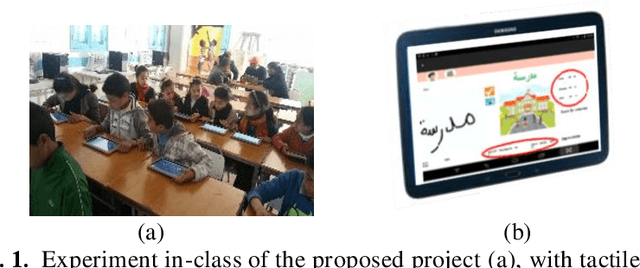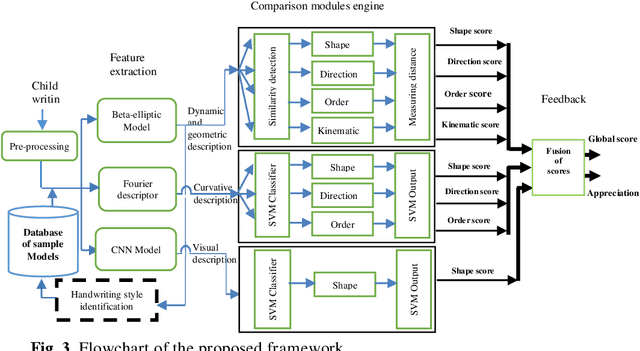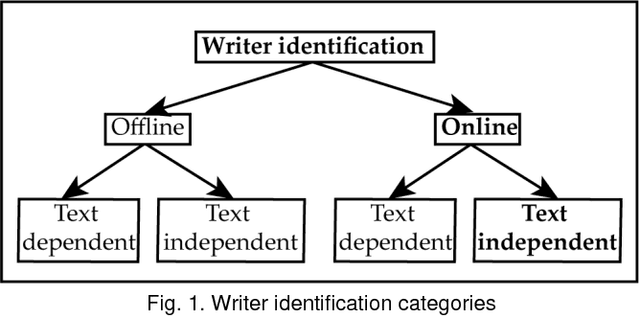Houcine Boubaker
Handwriting Quality Analysis using Online-Offline Models
Oct 09, 2020



Abstract:This work is part of an innovative e-learning project allowing the development of an advanced digital educational tool that provides feedback during the process of learning handwriting for young school children (three to eight years old). In this paper, we describe a new method for children handwriting quality analysis. It automatically detects mistakes, gives real-time on-line feedback for children's writing, and helps teachers comprehend and evaluate children's writing skills. The proposed method adjudges five main criteria shape, direction, stroke order, position respect to the reference lines, and kinematics of the trace. It analyzes the handwriting quality and automatically gives feedback based on the combination of three extracted models: Beta-Elliptic Model (BEM) using similarity detection (SD) and dissimilarity distance (DD) measure, Fourier Descriptor Model (FDM), and perceptive Convolutional Neural Network (CNN) with Support Vector Machine (SVM) comparison engine. The originality of our work lies partly in the system architecture which apprehends complementary dynamic, geometric, and visual representation of the examined handwritten scripts and in the efficient selected features adapted to various handwriting styles and multiple script languages such as Arabic, Latin, digits, and symbol drawing. The application offers two interactive interfaces respectively dedicated to learners, educators, experts or teachers and allows them to adapt it easily to the specificity of their disciples. The evaluation of our framework is enhanced by a database collected in Tunisia primary school with 400 children. Experimental results show the efficiency and robustness of our suggested framework that helps teachers and children by offering positive feedback throughout the handwriting learning process using tactile digital devices.
An Online Writer Identification System based on Beta-Elliptic Model and Fuzzy Elementary Perceptual Codes
May 30, 2018



Abstract:Actually, the ability to identify the documents authors provides more chances for using these documents for various purposes. In this paper, we present a new effective biometric writer identification system from online handwriting. The system consists of the preprocessing and the segmentation of online handwriting into a sequence of Beta strokes in a first step. Then, from each Beta stroke, we extract a set of static and dynamic features using four features extraction techniques based on the Beta Elliptic model and the Fuzzy Elementary Perceptual Codes. Next, all the segments which are composed of N consecutive Beta strokes are categorized into groups and subgroups according to their position and their geometric characteristics. Finally, Deep Neural Network are used for classification. Experimental results reveal that the proposed system achieves interesting results as compared to those of the existing writer identification systems on Latin and Arabic scripts.
A Hybrid NN/HMM Modeling Technique for Online Arabic Handwriting Recognition
Jan 02, 2014



Abstract:In this work we propose a hybrid NN/HMM model for online Arabic handwriting recognition. The proposed system is based on Hidden Markov Models (HMMs) and Multi Layer Perceptron Neural Networks (MLPNNs). The input signal is segmented to continuous strokes called segments based on the Beta-Elliptical strategy by inspecting the extremum points of the curvilinear velocity profile. A neural network trained with segment level contextual information is used to extract class character probabilities. The output of this network is decoded by HMMs to provide character level recognition. In evaluations on the ADAB database, we achieved 96.4% character recognition accuracy that is statistically significantly important in comparison with character recognition accuracies obtained from state-of-the-art online Arabic systems.8
 Add to Chrome
Add to Chrome Add to Firefox
Add to Firefox Add to Edge
Add to Edge